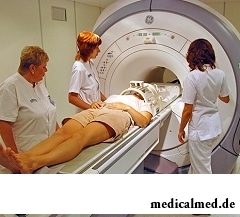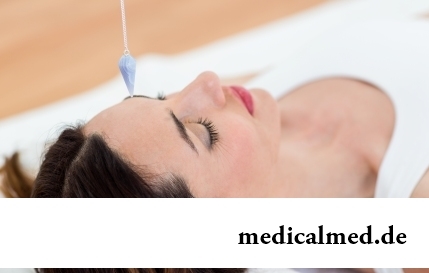





Arnold-Kiari's anomaly
Arnold-Kiari's anomaly – inborn defect in development of a rhombencephalon. This anomaly by discrepancy of the sizes of back cranial area and the brain components located in it is shown. As a result it leads to the fact that a part of almonds of a cerebellum and brain falls to a big occipital opening where they are restrained.
Reasons of development of anomaly of Arnold-Kiari
Statistically, this pathology is observed at 3-8 people from each 100 thousand.
Today the exact reason of development of anomaly of Kiari is not established. Most likely, display of this disease is accompanied by three following factors:
- traumatic damage of a wedge-shaped and occipital and wedge-shaped and trellised part of a slope as a result of a birth trauma;
- the inborn osteoneuropathies having a hereditary factor;
- hydrodynamic blow of cerebrospinal fluid in walls of the central channel of a spinal cord.
What anatomic changes happen at Arnold-Kiari's anomaly?
At this pathology the cerebellum is in a back cranial pole.
Normal the lower part of a cerebellum (almond) has to be located above a big occipital opening. At Arnold-Kiari's anomaly of an almond are located in the vertebral channel, that is under a big occipital opening.
The big occipital opening serves as a peculiar border between a backbone and a skull, and also between back and a brain. Over this opening the back cranial pole, and under it – the vertebral channel is located.
The lower part of a brainstem passes (myelencephalon) into a spinal cord at the level of a big occipital opening. Normal liquor (cerebrospinal fluid) has to circulate freely in subarachnoid spaces of a spinal and brain cord. These subarachnoid spaces connect among themselves at the level of a big occipital opening that provides free outflow of cerebrospinal fluid from a brain.
At Arnold-Kiari's anomaly of an almond are located under a big occipital opening that complicates free current of liquor between a head and spinal cord. Almonds of a cerebellum block a big occipital opening like a stopper that significantly breaks outflow of cerebrospinal fluid and leads to development of hydrocephaly.
Types of anomaly of Arnold-Kiari
In 1891 Kiari defined four main types of pathology and in detail described everyone. Doctors use this classification also till today.
- 1 type. Omission of structures of a back cranial pole below the plane of a big occipital opening is characteristic of it.
- 2 type of which caudal dislocation of lower parts of a skull, the 4th ventricle and myelencephalon is characteristic. Quite often it is followed by hydrocephaly.
- 3 type. This type of a disease is quite rare and the rough caudal shift of all structures of a back cranial pole is characteristic of it.
- 4 type when the hypoplasia of a cerebellum occurs without its shift down.
The third and fourth types of anomaly of Arnold-Kiari will not respond to treatment and, as a rule, lead to a lethal outcome.
At preferential most of patients (about 80%) Arnold-Kiari's anomaly is combined with a myelosyringosis – pathology of a spinal cord of which formation of the cysts in it promoting development of the progressing myelipathy is characteristic. Similar cysts at omission of structures of a back cranial pole are formed and as a result of a prelum of cervical department of a spinal cord.
Symptoms of anomaly of Arnold-Kiari
 The following clinical signs are characteristic of this pathology:
The following clinical signs are characteristic of this pathology:
- loss of temperature and painful sensitivity of upper extremities;
- the pain in cervicooccipital area amplifying during the sneezing and cough;
- visual acuity loss;
- loss of an animal force of upper extremities;
- frequent dizzinesses, faints;
- spasticity of the lower and upper extremities.
At more started disease stages weakening of a gag reflex, episodes of an apnoea (temporary cessation of breathing) and the involuntary bystry movements of eyes join symptoms of anomaly of Arnold-Kiari.
This disease is fraught with development of the following complications:
- The paralysis of nerves of a skull, infringement of cervical department of a spinal cord, dysfunction of a cerebellum happening against the background of the progressing symptoms of intracranial hypertensia.
- Sometimes, that this pathology connects to defects of a skeleton: occipitalization of the Atlas or basilar impressiya (funneled impression of a craniospinal joint and slope).
- Deformations of feet, anomalies of a backbone.
Sometimes Arnold-Kiari's anomaly passes asymptomatically and it is found only when carrying out the general research of the patient.
Diagnosis of anomaly of Arnold-Kiari
The main diagnostic method of this disease is MRT of chest and cervical departments of a spinal cord and MRT of a brain today. MRT of a spinal cord do preferential for the purpose of detection of a myelosyringosis.
Treatment of anomaly of Arnold-Kiari
If the disease has only one symptom – pain in a neck, then treatment of anomaly of Arnold-Kiari generally conservative. Therapy includes various schemes with use of muscle relaxants and nonsteroid antiinflammatory medicines.
If the effect of conservative treatment insufficient or is absent at all for 2-3 months of treatment, and also in the presence at the patient of symptoms of neurologic insufficiency (weakness and numbness of extremities, etc.), then the doctor, as a rule, offers carrying out operation at Arnold-Kiari's anomaly.
Main goal of carrying out operation at Arnold-Kiari's anomaly is minimizing of infringement of nerve terminations and fabrics and normalization of outflow of cerebrospinal fluid for what the size of a back cranial pole is a little increased in volume. As a result of operation at Arnold-Kiari's anomaly the headache completely disappears or decreases, motive functions and sensitivity of extremities are partially recovered.
The educated person is less subject to brain diseases. Intellectual activity promotes formation of the additional fabric compensating sick.

Nightmares belong to the most unpleasant frustration. Statistically, they happen at 4% of adults, and almost at 70% of children and...
Section: Articles about health
No, probably, the person who would not have cold. Cold, cough, a headache – these symptoms are known to everyone. The peak of catarrhal diseases is the share of fall. SARS already came to schools and kindergartens, flu slowly makes the way to the cities, in a word, з...
Section: Articles about health
Turnip, radish, horse-radish – once these and other products enjoyed wide popularity at our ancestors, being not only the food sating an organism but also the medicines curing of many diseases. Unfortunately, the use of some of them got out of fashion long ago, and once favourite plants and vegetables almost ceased to make a contribution to human health. Inclusion of such products in a modern diet − an effective measure of prevention and treatment of diseases which seldom suffered...
Section: Articles about health
Heart disease and blood vessels lead to disturbance of blood supply of bodies and fabrics that involves failures in their works...
Section: Articles about health
Epilepsy is one of widespread neurologic diseases. Parents, whose children suffer from this illness, should face rumors and delusions, many of which remained since the Middle Ages....
Section: Articles about health
Aging — natural and inevitable process. Over time our skin loses elasticity, on it saggings are formed, the face form loses former clearness. The procedure of nitevy lifting (nitevy tightening) can successfully solve this problem. In order that it is better to get acquainted with this popular procedure, we will tell you 6 cognitive facts about it....
Section: Articles about health
Color of plants is caused by presence at them of certain chemical compounds. Let's talk that various colors mean vegetable...
Section: Articles about health
New year, wedding, birthday, office party – an occasion to drink at the Russian person will always be. How to reduce a negative impact of alcohol by an organism and to avoid a condition of strong intoxication? The most correct council – to refuse the use spirits напитк...
Section: Articles about health
From sexual contacts each person can test insufficiently strongly expressed sexual desire or lack of satisfaction from time to time. However when it happens regularly, it is an occasion to think about health. Most of people does not hurry to ask similar questions physicians: one consider that they will be able to cope with malfunctions independently, others hesitate to report to strangers about so delicate problems and hope that troubles will stop by itself....
Section: Articles about health
The endocrine system carries out in a human body extremely important role, practically all processes of life activity регулируютс...
Section: Articles about health
What is in our understanding weeds? It plants which are considered to be suitable only for compost pits and feeding of animals. Meanwhile, among the weeds growing literally under legs it is possible to find the mass of the officinal herbs possessing invaluable Paul...
Section: Articles about health
Cold – a state known to everyone which is followed by cold, cough, high temperature, a pharyngalgia. Often the first that we begin to do in hope again to become healthy – to accept medicines which are not always harmless whereas it is easy to facilitate displays of a disease by means of natural means. They not only softly eliminate disease symptoms, but also enrich the weakened organism with useful substances. We present you 8 drinks which are successfully used for...
Section: Articles about health
Food with the increased content of sugar is attractive to most of people - it is scientifically confirmed fact. Business here not in a nevozder...
Section: Articles about health
For the person who daily since morning gathers for work it is very important to wake up vigorous and ready by day of work. Actually, each of us experiences difficulties with this, at first sight, simple business from time to time. On a condition of an organism after ночн...
Section: Articles about health
Life expectancy in various regions of Earth is not identical. Social stability, economic wellbeing, availability and level of medical care, household comfort, literacy of the population in the field of respect for sanitary and hygienic norms and many other factors exert impact on it. However one parameter remains to the general almost for all countries of the world: women on average live for 7-10 years longer, than men. Today we will talk about the reasons of this phenomenon....
Section: Articles about health
Very often as a source of the infection which caused a disease serves our house - the place which a priori has to be safe. However...
Section: Articles about health
It is known that the person for 80% consists of water which participates in all processes of an organism. The person loses liquid daily – as a result of sweating, breath, an urination, and its insufficient completion due to various reasons can bring to обезвожив...
Section: Articles about health
Striya (extension) are the defects of skin having an appearance of direct or wavy strips from 1 to 10 cm long and 1-5 mm wide. In most cases at women of a striya are located on a stomach, hips, a breast or buttocks. At athletes they can appear on shoulders and the internal surface of forearms. At initial stages of development of an extension have red or lilac color, but over time their coloring turns pale, and strips become whitish, getting a nacreous shade....
Section: Articles about health
The state of health of the person in many respects depends on food. The organism will well function if during food it are...
Section: Articles about health
History of use of an anesthesia during operations contains more than 160 years. Annually in the world hundreds of thousands of surgical interventions during which to patients the substances immersing them in a dream and saving from pain are entered are carried out. Using an anesthesia to these...
Section: Articles about health
Practice of hypnotic impact on consciousness of the person contains about two millennia. During this time scientists managed to learn a lot of things about a phenomenon of hypnosis and learned to facilitate a condition of the patients having heavy illnesses with its help....
Section: Articles about health
There is an opinion that at low temperatures safety of products is ensured longer and better thanks to what the refrigerator considers...
Section: Articles about health
The sudden heat on all body which is followed by perspiration and a cardiopalmus – the phenomenon familiar to many people. Most often such states called by "inflows" result from nervous or physical overworks and disappear right after rest. Odn...
Section: Articles about health
Olive oil – the product capable to make a powerful contribution to health of the person if it includes it in the diet. The rich vitamin composition of oil does it by a product number one from many diseases including from deadly. Only two tablespoons of oil from olives in day prevent emergence of diseases of vessels and heart, cancer, problems with digestion, presenilation, a depression and many other illnesses which treatment would demand a lot of time and forces. Let's consider on...
Section: Articles about health
Practice of use of table salt in the therapeutic purposes contains not one century. Appl are considered especially effective...
Section: Articles about health
Reactive pancreatitis - the disease which is characterized by inflammatory process in a pancreas which arises most often because of excess activity of digestive enzymes. It − the emergency state which treatment has to take place in хирургич...
Section: Articles about health
The mankind knows that some toxins at intake in the minimum quantities have therapeutic effect from an extreme antiquity. Many substances recognized poisonous are applied in the medical purposes also today, being the main operating components of the medicines which are officially produced by pharmaceutical industry. Let's tell only about the most known of them....
Section: Articles about health
